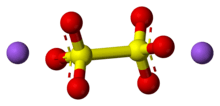Sodium dithionate
Sodium dithionate Na2S2O6 is an important compound for inorganic chemistry. It is also known under names disodium dithionate, sodium hyposulfate, and sodium metabisulfate. The sulfur can be considered to be in its +5 oxidation state.
 | |
 | |
| Names | |
|---|---|
| IUPAC name
Sodium dithionate | |
| Other names
Sodium hyposulfate | |
| Identifiers | |
3D model (JSmol) |
|
| ChemSpider | |
| ECHA InfoCard | 100.028.682 |
| EC Number |
|
PubChem CID |
|
| UNII | |
CompTox Dashboard (EPA) |
|
| |
| |
| Properties | |
| Na2S2O6 | |
| Molar mass | 206.106 g/mol |
| Appearance | White crystalline powder |
| Density | 2.19 g/cm3 |
| Melting point | 190 °C (374 °F; 463 K) (decomposes) 52 °C (dihydrate) |
| Boiling point | 267 °C (513 °F; 540 K) decomposes |
| 6.27 g/100 mL (0 °C) 15.12 g/100 mL (20 °C) 64.74 g/100 mL (100 °C) | |
| Hazards | |
| NFPA 704 (fire diamond) | |
Except where otherwise noted, data are given for materials in their standard state (at 25 °C [77 °F], 100 kPa). | |
| Infobox references | |
- For the sterilizing agent, see sodium metabisulfite. For the reducing agent, see sodium dithionite.
It should not be confused with sodium dithionite, Na2S2O4, which is a very different compound, and is a powerful reducing agent with many uses in chemistry and biochemistry. Confusion between dithionate and dithionite is commonly encountered, even in manufacturers' catalogues.
Preparation
Sodium dithionate is produced by the oxidation of sodium bisulfite by manganese dioxide:[1]
- 2 NaHSO3 + MnO2 → Na2S2O6 + MnO + H2O
Alternatively, it can be prepared by the oxidation of sodium sulfite by the silver(I) cation:[1]
- Na
2SO
3 + 2 Ag+
+ SO2−
3 → Na
2S
2O
6 + 2 Ag
Another method is via oxidation of sodium thiosulfate with chlorine:
- 3 Cl2 + Na2S2O3·5H2O + 6 NaOH → Na2S2O6 + 6 NaCl + 8 H2O
And another method to produce sodium dithionate is treating sodium thiosulfate with sodium hypochlorite solution.
Structure
The dithionate ion represents sulfur that is oxidized relative to elemental sulfur, but not totally oxidized. Sulfur can be reduced to sulfide or totally oxidized to sulfate, with numerous intermediate oxidation states in inorganic moieties, as well as organosulfur compounds. Example inorganic ions include sulfite and thiosulfate.
Sodium dithionate crystallize as orthorhombic crystals of the dihydrate (Na
2S
2O
6). The water of crystallization is lost when heated to 90 °C, and the structure becomes hexagonal.[2]
Large single crystals of (Na
2S
2O
6 .2H
2O) have been grown and studied for pulsed lasing purposes (pico second spectroscopy) with great success by E. Haussühl and cols.[3]
Properties
Sodium dithionate is a very stable compound which is not oxidized by permanganate, dichromate or bromine. It can be oxidized to sulfate under strongly oxidizing conditions: these include boiling for one hour with 5 M sulfuric acid with an excess of potassium dichromate, or treating with an excess of hydrogen peroxide then boiling with concentrated hydrochloric acid. The Gibbs free energy change for the oxidation to sulfate is about −300 kJ/mol.
In addition, the (S
2O
6) anion is not a good reducing group. Therefore, it has been used to form single crystals of large cation complexes in high oxidation states without reduction of the metallic complex.
References
- W. G. Palmer (1954). Experimental Inorganic Chemistry. CUP Archive. pp. 361–365. ISBN 0-521-05902-X.
- D. W. Larson; A. B. VanCleave (February 1963). "X-Ray Diffraction Data for Alkali Dithionates". Canadian Journal of Chemistry. The National Research Council of Canada. 41 (2). doi:10.1139/v63-035.
- Haussühl, E.; A. A. Kaminskii (2010). Laser Physics. 15 (5): 714–727. Missing or empty
|title=(help)
